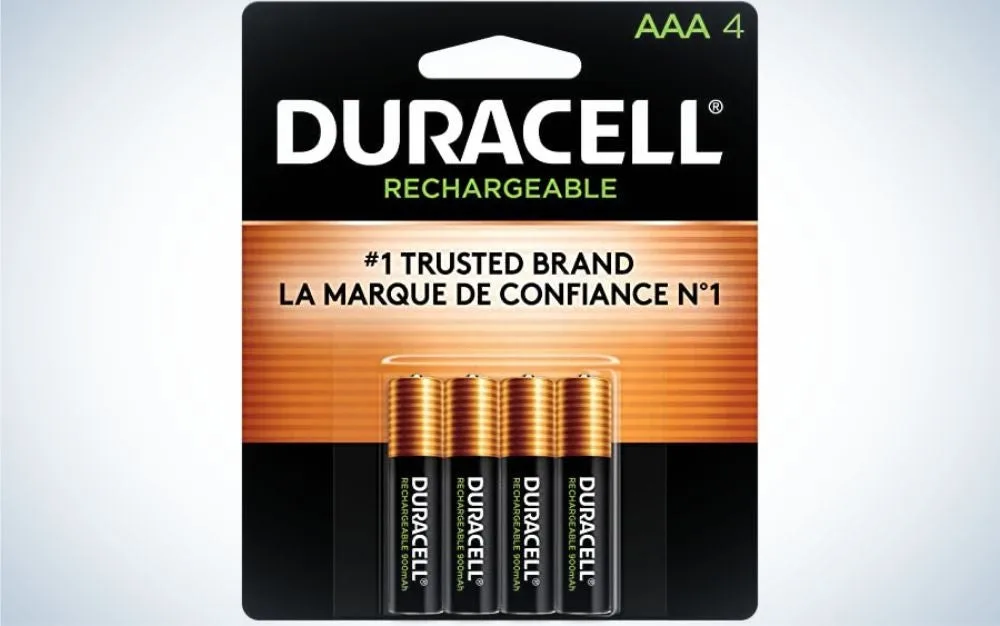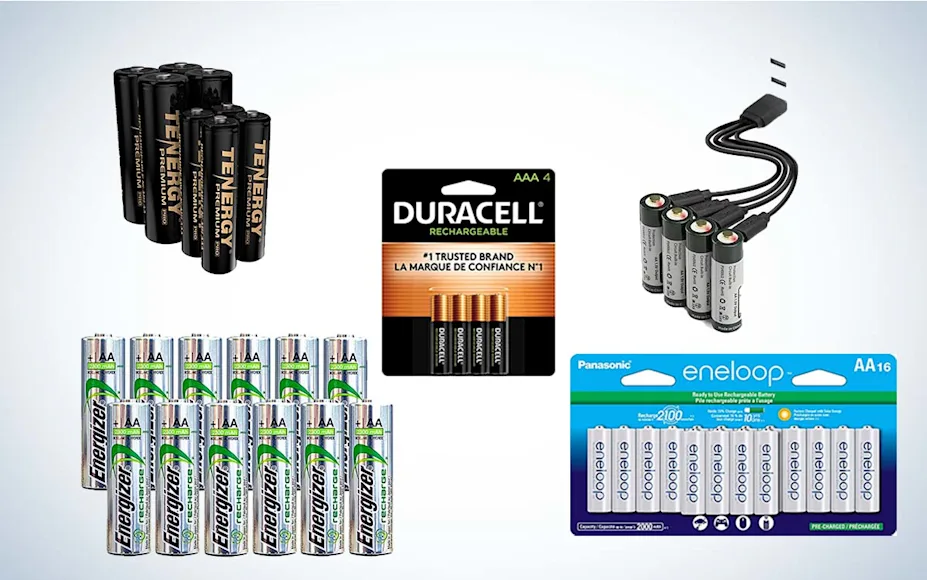_We may earn revenue from the products available on this page and participate in affiliate programs. Learn more ›
_
Best Overall

Panasonic Eneloop AA
LEARN MORE
Summary
The Panasonic Eneloop AA batteries are long-lasting, store well, and have a high energy capacity.
Most Eco-Friendly

Energizer Recharge Universal AA
LEARN MORE
Summary
Made from recycled batteries, the Energizer Recharge Universal AA is not only a reliable battery option, but it is more sustainable than the rest on the market.
Easiest to Charge

Keeppower USB Rechargeable Lithium-Ion Batteries
LEARN MORE
Summary
The Keeppower USB Rechargeable batteries use a universal micro-USB charging port, making it one of the easiest to charge.
Rechargeable batteries are becoming less popular as more of our devices become rechargeable. However, you don’t need to upgrade an older electronic that runs off AA or even AAA batteries when you can get rechargeable batteries instead.
Usually, rechargeable batteries are a bit more expensive up front, but the future cost-benefit will make it all worth it. Single-use batteries not only add up in dollar signs but also waste (including improper disposal in landfills). While you can recycle all batteries, this type of recycling isn’t very accessible to consumers. When buying rechargeable batteries, you want to make sure they are made well enough and perform for years to justify the purchase. The best rechargeable batteries will not only be affordable, but they are long-lasting, easy to charge, and compatible with your devices.
Best Overall: Panasonic Eneloop AA
Most Eco-Friendly: Energizer Recharge Universal AA
Easiest to Charge: Keeppower USB Rechargeable Lithium-Ion Batteries
Best AAA: Duracell Rechargeable StayCharged AAA
Best Budget: Tenergy Rechargeable NiMH Batteries
How We Choose The Best Rechargeable Batteries
Besides ease of use and affordability, we chose our top picks for the best rechargeable batteries based on the overall power, charging time, and how many times you can charge them before they no longer work.
How well they store, if they often self-discharge, and how easy they are to recycle were also considered. Some input came from personal experience with the products, company research, and verified customer reviews.
The Best Rechargeable Batteries: Reviews & Recommendations
Best Overall: Pa
Best Overall

Key Features
Type: NiMH
Capacity: 2000 mAh
Lifespan: 2100 charges
Pros
Can be stored and hold most of its charge
Also available in AAA, C, and D
Usable in temperatures as low as -4F
Cons
Must use a company-specific charger to prevent issues
The Panasonic Eneloop AA batteries are our top pick for the best rechargeable batteries. Once the Sonya Eneloop, these are the same product but rebranded. They come precharged, ready to use, and have one of the best storage capabilities. Even after ten years of storage, they are known to hold anywhere from 70-85% of their full charge. That means even if you charge them and toss them in your drawer, you can trust that they will be ready when you need them.
They can get really hot when you are charging and using them, which isn’t ideal, and make sure you always use the charger provided to you by the brand. Using other chargers not designed for these batteries specifically can cause them to fail or, even worse, short-circuit, expelling gas.
For the money, you are getting a long-lasting battery with excellent holding power and energy capacity. While there are many comparable batteries to this one, most of them will not store as well or have as long of a lifespan.
Most Eco-Friendly: Energizer Recharge Universal AA
Most Eco-Friendly

Key Features
Type: NiMH
Capacity: 2000 mAh
Lifespan: 1000 charges
Pros
Made from recycled materials
Long lifespan
Also available in AAA, C, D, and 9V
Charge lasts up to 1 year in storage
Cons
Can malfunction when overcharged
Get very hot during charging
Reusable batteries are already more sustainable than single-use ones, but Energizer decided to take things a step further. The Energizer Recharge Universal batteries are the first on the market to incorporate recycled batteries into their product materials. Unfortunately, they do not use 100% recycled materials, and some batteries will have only 15% or less recycled materials. While this is not perfect, it is still a step in the right direction.
Whether or not they are 100% recycled materials, they still work quite well. They have an excellent lifespan so long as you do not overcharge them. This can be tricky for some people as they charge them overnight and forget about them, but this can cause them to malfunction and shorten their lifespan.
They come in various battery sizes, can be charged up to 1000 times, can be stored for up to one year while still holding a charge, and have excellent energy capacity. Overall, these are great batteries and the first to incorporate recycled batteries into their line.
Related: How to Recycle Used Batteries
Easiest to Charge: Keeppower USB Rechargeable Lithium-Ion Batteries
Easiest to Charge

Key Features
Type: Lithium-Ion
Capacity: 2260 mAh
Lifespan: 1000 charges
Pros
Full charge light change
Plugs into a USB port for charging
Fast charge time (lithium-ion)
Safety circuit to prevent over-discharge and overcharging
Cons
No cover to USB port making it hard to keep clean
While none of the charging docks most batteries have are inconvenient, the Keeppower USB Rechargeable LIthium-Ion Batteries utilize a unique micro-USB four-prong charger. This makes it easy to charge them while you are on the go and makes the batteries compatible with any other micro-USB charger.
The downside to the charging method is that there is no cover on the port. So, when they are not in use, ensure they are stored somewhere that won’t collect crumbs or clog up the port. People with large hands or poor coordination may struggle as it takes more precision to plug each battery into the charger.
They utilize lithium-ion batteries, which charge much faster (90 minutes). You’ll also know they’re done charging as the light turns from red to blue. Plus, you don’t need to worry about overcharging because they have a safety circuit built into each battery to prevent that.
Best AAA: Duracell Rechargeable StayCharged AAA
Best AAA

Key Features
Type: NiMH
Capacity: 1350 mAh
Lifespan: 400 charges
Pros
Excellent shelf life
Relatively fast charge time
Also available in AA sizes
Compatible with any NiMH battery charger
Cons
Short lifespan
The best rechargeable batteries wouldn’t be complete without the best AAA batteries. Duracell is a reputable and trusted battery company with rechargeable options. These Duracell Rechargeable StayCharged AAA batteries may not have the best lifespan (only 400 charges), but they function well and store for up to 10 years.
Duracell rechargeable batteries can charge using any NiMH-compatible battery charger. They won’t take long to charge even though they are NiMH batteries since they have an energy capacity of 1350 mAh.
Having reusable AAA batteries on hand is perfect for any survival or emergency kit. Since these store for so long compared to some other brands, these are one of our favorites for rechargeable AAA batteries.
Best Budget: Tenergy Rechargeable NiMH Batteries
Best Budget

Key Features
Type: NiMH
Capacity: 2000 mAh
Lifespan: 1200 charges
Pros
AAA also available
Stores for up to 1 year holding its charge
Great value for the price
No leak design
Cons
Advertised as compatible with any NiMH charger, but doesn’t always reliably charge
Rechargeable batteries are always going to cost more than single-use ones up front. These “budget” ones are no different. While the price may be surprising for this pick, they are the best value for what you get. The Tenergy Rechargeable NiMH Batteries have an excellent lifespan, and you can buy them in a mixed pack to include AA and AAA batteries.
The mAh of the batteries is excellent, and they even come with a 12-month warranty. While their storage ability may not rank the highest, they can still be stored for one year and hold around 85% of their original charge.
Overall, these are an excellent value for the price, especially since they are said to be compatible with any NiMH charger.
What to Consider When Choosing Rechargeable Batteries
Beyond how many batteries you need and the size (AA, AAA
, etc.), knowing the type of battery, battery capacity, how it charges, and how long it will last should all be considered before buying rechargeable batteries.
Battery Type
Lithium-ion and nickel-metal hydride (NiMH) is likely the most common type of battery you’ll see when shopping for rechargeable batteries. Knowing the difference between them can help you decide which kind fits your needs best.
Even though those two are potentially the most widely used, there are four types of rechargeable batteries sold for at-home use:
Lithium-Ion: lightweight, powerful, and easy to charge, lithium-ion batteries are generally used for things like phones, laptops, and solar panels. They store well, do not self-discharge, and charge quickly. They are not the most powerful battery option, but they are reliable.
NiMH: potentially the most widely used rechargeable batteries, they are long-lasting and have a very high energy capacity. These are ideal for powering things like lights, cameras, and other electronics that use a lot of power. While they are durable, they can take longer to charge and have the potential to self-discharge.
NiCD: an affordable battery type, NiCD batteries are popular for power tools. While these tend to have a pretty level power output (flat discharge), they can fall off fast as the battery depletes. Since they have good pulse power performance, it makes sense they work well for power tools.
Alkaline: with a long battery life and high energy output, alkaline batteries are ideal for low-to-mid-drain electronics. An alkaline battery is the best option when you want to power something that you use daily but doesn’t need a ton of power to function (like a clock or remote).
Capacity
The type of battery can have a considerable impact on how well they work for your needs, but the next thing to look at is the battery’s energy capacity. Most rechargeable batteries list this as the electric power in milliamp-hours (mAh).
Without getting too deep into it, what you need to know is the higher the mAh, the longer the battery should last. Avoid mixing batteries with different capacities when running one device as a lower capacity will drain much faster, negatively impacting both of the batteries being used.
For example, when looking at NiMH AA batteries, a disposable option should be anywhere from 1200-2000 mAh, while a rechargeable should sit between 1700-2500 mAh. These differences will also occur between AA and AAA batteries. Most AA batteries sit around 2500 mAh, while AAA batteries will be closer to 900 mAh. If you want a long-lasting battery, look for at least 2500 mAh, but some rechargeable batteries can be as high as 2800 mAh.
Charging
How long it takes to charge the battery, how long the charge lasts, and how many times you can charge the reusable batteries before they no longer work are all important considerations.
Quality NiMH AA batteries may take up to 4 hours to fully charge. Since NiMH batteries can fully discharge, they often take longer than lithium-ion batteries to charge. The company should always list charge times on the package or product listing on the website. Pay attention to this, so you know how many packs to buy and if that charge time works for you. The charge time is associated with the energy capacity, so be aware that the higher capacity batteries will take longer to charge regardless of their battery type.
Most rechargeable batteries come precharged and ready to use. This is a great feature, but this isn’t a standard. When reading about products, pay close attention to these types of features and specs.
How long a battery lasts is also important to note. What you use the battery for can impact how long the battery lasts, and higher-power devices like flashlights, headlamps, and toys drain batteries faster.
Since rechargeable batteries are intended to be recharged several times before they stop working, they should be rechargeable at least 400-1000 times before they lose power. The quality and type of battery will impact how many times they can be recharged. Once they run out of life, recycle them appropriately and never dispose of batteries in the trash.
FAQs
Q: Which rechargeable batteries last the longest?
The rechargeable batteries that last the longest are potentially our number one pick, the Panasonic Eneloop AA batteries. These have one of the longest runtimes and lifespans of any rechargeable battery on the market. There are some comparable batteries, but these are front runners.
Q: Which is better a NiMH or lithium-ion battery?
Both NiMH and Lithium-Ion batteries have their pros and cons. Many rechargeable batteries are NiMH because they have a higher energy density and can be brought entirely down to a zero charge. Lithium-Ion batteries tend to be smaller and lighter and can be more reliable as they have a lower self-discharge risk. Lithium-Ion batteries also tend to charge faster, but they also won’t last as long because they have a lower capacity.
Q: What’s the best charger for rechargeable batteries?
The best charger for rechargeable batteries is the one that is recommended by the manufacturer or comes with the purchase of the batteries themselves. Some universal batteries may use a standard USB connection cord, but most require a docking station to charge them.
Q: Is it worth buying rechargeable batteries?
It is worth buying rechargeable batteries, mainly if you use battery-powered devices often. Rechargeable batteries save you money in the long run and are better for the environment as well. While they still have an end of life, you won’t have as many batteries to recycle, nor will you have to do it as often.
Final Thoughts on the Best Rechargeable Batteries
Rechargeable batteries are a great way to save money and reduce the waste of single-use batteries. The best rechargeable batteries have a long lifespan, are easy to charge, and have a decent runtime. It is tempting to always jump to the cheapest option, but the point of rechargeable batteries is that they will last a long time. Look at the big picture and invest in a pack of batteries that can power your gadgets for years to come.
Why Trust Us
For more than 125 years, Field & Stream has been providing readers with honest and authentic coverage of outdoor gear. Our writers and editors eat, sleep, and breathe the outdoors, and that passion comes through in our product reviews. You can count on F&S to keep you up to date on the best new gear. And when we write about a product—whether it’s a bass lure or a backpack—we cover the good and the bad, so you know exactly what to expect before you decide to make a purchase.






